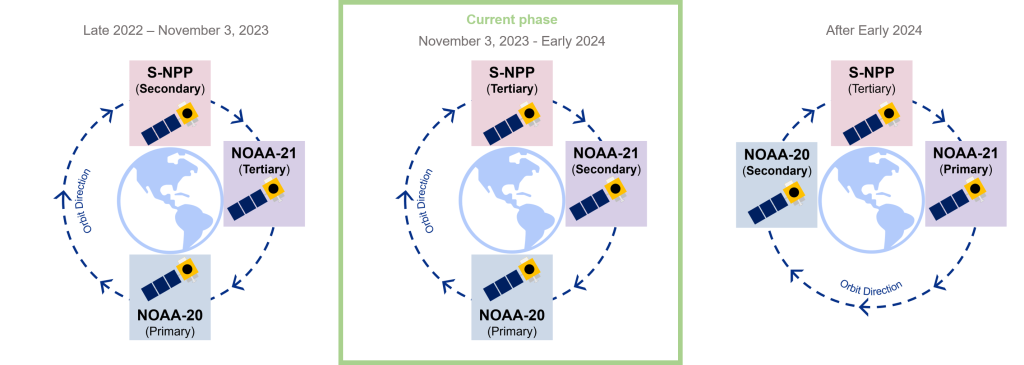NOAA-21 Designated as the Secondary JPSS Satellite
Per NOAA Office of Satellite and Product Operations (OSPO), the last requirement was fulfilled to declare NOAA-21 operational and as the secondary satellite of the JPSS constellation. As of 3 November 2023, the three existing JPSS satellites are now designated in the following order: Primary – NOAA-20, Secondary – NOAA-21, and Tertiary – SNPP. This change should not effect the data distribution, however, the 3 JPSS satellites are operated in the new prioritized order. For instance, the primary and secondary satellites (in this case, NOAA-20 and NOAA-21) take priority in data processing and spacecraft maneuvers.
In the incoming months, once the majority of NOAA-21 datasets reach provisional maturity or better, the NOAA-21 satellite will be assigned as the primary satellite. NOAA-20 will then become the secondary satellite, and SNPP, the tertiary satellite. With respect to SNPP, the tertiary designation indicates that any non-nominal issue or ground resource constraint will be addressed under a best-effort basis, unless a satellite or instrument health and safety issue occurs.
The current and future JPSS satellite designations and orbital configurations can be seen in the image below. Refer to the current phase highlighted in the green box, and the last phase located to the right, titled, ‘After Early 2024’. Image credit, thanks to TOWR-S/NOAA.

We look forward to NOAA-21 becoming the primary satellite in the JPSS constellation in 2024, along with the updated JPSS orbital configuration. Once NOAA-21 becomes the primary satellite, NOAA-20 and NOAA-21 will be separated by a 1/2 orbit (~50-min apart), with SNPP placed 1/4 orbit between the two.
Sources: NOAA OSPO – N21 Secondary Satellite in Constellation Declaration, NOAA NESDIS – N21 is Operational, and NOAA/NWS/TOWR-S.
